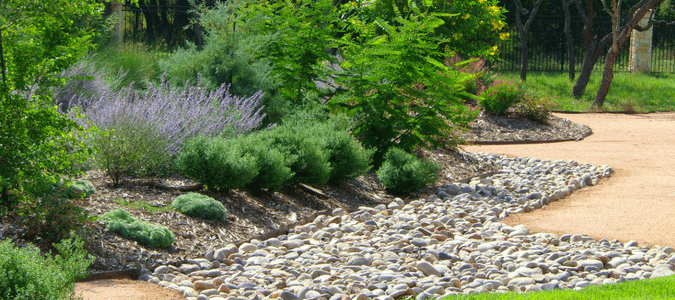
Depending on the source, Texas has either four, five or even seven geographical regions, each with its own distinct features and climatic conditions. Whatever the number, we can all agree that different areas of the state are host to varying plant species based on unique patterns of hot and cold weather, seasonal rainfall and other factors, all of which affect the types of Texas landscaping plants that gardeners can choose from to elevate the aesthetic of your outdoor spaces.
Soil composition also varies from one region of Texas to another. Many portions of the state feature rocky or sandy soil, which won’t support certain popular varieties of plants and trees without much careful intervention on the part of the gardener. Converting dry, well-draining soil into something that will support plants not well suited for the region involves complicated and expensive processes of soil building, heavy watering and more.
Instead of fighting against the natural soil and climate conditions of your area, why not work with them? Savvy Texas gardeners can cultivate thriving, beautiful gardens simply by choosing plants and trees that can flourish in your area, whether they are native to the region or not. Whether you are looking for landscaping ideas in Houston or in other parts of the state, read on for landscape designer recommendations for sunny yards, shady spots or a blend of both.
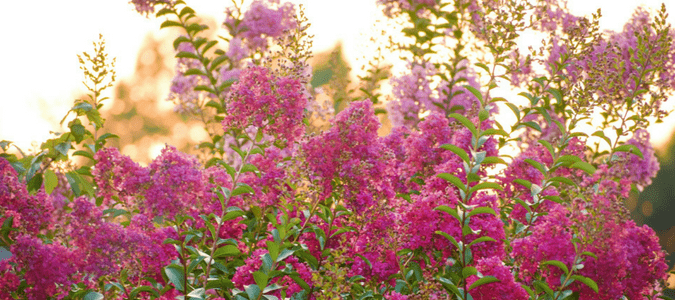
Landscaping Ideas: Texas Trees and Large Shrubs
Texas is home to many native species of large and tall trees and shrubs, plus many species that originated elsewhere and then were naturalized to this area. Choose from the following varieties for garden accents or focal points that will transform your yard into the envy of the neighborhood.
crape Myrtle
Want a tree that thrives instead of wilts during our brutal summers? Sometimes referred to as the lilac of the South, this species (sometimes referred to as crape myrtle) is not native to the United States, but does well in our warm climate after it has been established, which takes about two years. Available in a variety of colors and sizes, crape myrtles are considered low maintenance as long as you choose the variety that will work best in your landscape. Ideally, plant in an area which is well drained and which gets full sun and adequate air circulation. crape myrtles in shady spots will have fewer flowers and can be more vulnerable to disease.
Mexican Redbud
More drought tolerant than Texas redbud, these small trees are perennials with low water needs, which is very important in the hottest and most arid regions of the state. They do best in full sun or partial shade, and thrive in rocky, sandy, well-draining soil. One of the first trees to bloom in the spring, Mexican redbuds’ gorgeous, deep-pink and purple blossoms will attract both butterflies and bees to your garden.
Texas Mountain Laurel
With its cascading bunches of purple flowers that many gardeners claim smell like grape soda, Texas mountain laurels are a favorite native ornamental tree among Texas gardeners. These trees grow relatively quickly and can be drought tolerant once established. They are also versatile as far as size and shape: They can be pruned to a large shrub or cultivated to grow into a tall tree with single or multiple trunks.
Eve’s Necklace
A cousin to the Texas mountain laurel, Eve’s necklace thrives in central and northern Texas. This small tree produces clusters of pink flowers in spring and early summer. This plant can thrive in full or partial sun or even in full shade, and once established is both heat and drought tolerant.
Chaste Tree
Also called lilac chaste tree, sage tree or Indian spice, chaste trees are not Texas natives, but they do thrive in our state’s hot, often arid conditions. Many Texas gardeners love chaste trees for their exotic-looking spikes of violet-colored flowers, which bloom from May through September. Chaste trees can be pruned to large shrubs or encouraged to grow into small trees. They do best in full sun and can thrive in a variety of soils as long as the soil is well-draining. Once established, chaste trees are hardy through droughts and temperature extremes.
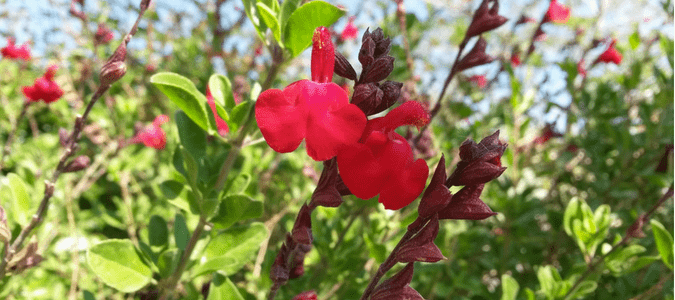
Best Flowers To Plant In Texas
Many of the best flowers to plant in Texas are small flowering shrubs. Some of the following varieties would look at home in anything from a xeriscaped garden featuring mostly native plant varieties to an elegant showstopper of a Texas garden with purple Texas wildflowers and other drought-tolerant species.
Coreopsis
This flowering plant loves full sun and does not need much water. Coreopsis grandiflora is a popular variety; it grows to between two and three feet tall, with sunny, golden-yellow flowers that are about two inches in diameter.
Salvia coccinea
Known by a variety of names including red sage, scarlet sage and Indian fire, salvia coccinea is a beautiful and fragrant addition to Texas gardens. Since it thrives in sandy soil and in heat, it makes a great addition to yards in the southern and central parts of the state. It can grow well in shade or full sun, in moist or dry soil. It needs a fair amount of water right after planting, but once established, its water needs are on the lower side. Best of all, red sage’s vibrant, flute-shaped flowers attract hummingbirds, along with bees and butterflies, while its spicy-smelling, pungent leaves and stems are a turnoff to deer.
Indigo Spires Salvia
This variety of salvia, which takes its name from its dark-blue flowers, is resistant to disease as well as heat and drought. As with salvia coccinea, deer are not attracted to this perennial.
Lantana
This flowering bush is familiar to most of us Texans, as it is common across the state. The plant grows quickly and draws bees and butterflies with its bright, cheery clusters of tiny flowers. You can choose a variety of lantana with almost any color combination to accent your particular garden, including red, pink, yellow, orange or white flowers. Some types of lantana grow to large shrubs, while others stay lower to the ground and spread. Whichever variety you choose, be sure to cut it back in late winter in order to encourage fresh spring growth. You can prune it to within a few inches of the ground and it will still return to full flowering glory by mid-spring.
Russian Sage
Not a Texas native, Russian sage has adapted well to our local climate. This perennial has low water needs and thrives in full-sun locations. Its spikes of bluish-lavender flowers provide a pretty contrast to its silvery-green leaves, and create a lovely border or accent in any garden.
Rock Rose
This small bush produces delicate pink flowers that look like mini-hibiscus blooms, and its leaves have a delicate and velvety appeal. Very drought and heat tolerant, especially once established, rock rose bushes grow to two or three feet in height, but can become quite sprawling if not pruned back.
Turk’s Cap
Native to southern Texas, Turk’s cap is a good choice for any garden in need of a pop of bright red or pink color. A perennial shrub, Turk’s cap grows to several feet in height and width, and is moderately deer resistant. It thrives as well in full sun as in shade, and draws both hummingbirds and butterflies to its vibrant blooms.
Coral Vine
Also known as Mexican creeper or San Miguelito vine, this flowering vine is native to Mexico, but thrives in many areas of southern, central and western Texas. Coral vines grow quickly in spring, sending out wiry, curly offshoots to “climb” trellises, fences and walls. These vines bloom profusely in late summer and early fall with bountiful spills of tiny, delicate pink flowers.
Coral vines’ leaves and stems die off with the first cold snap of the season. If you prune the plants back nearly to the ground, you’ll be rewarded the following spring with fresh, abundant vine growth when temperatures warm up once again. This plant is highly heat and drought tolerant, making it perfect for gardens in nearly any region of the state.
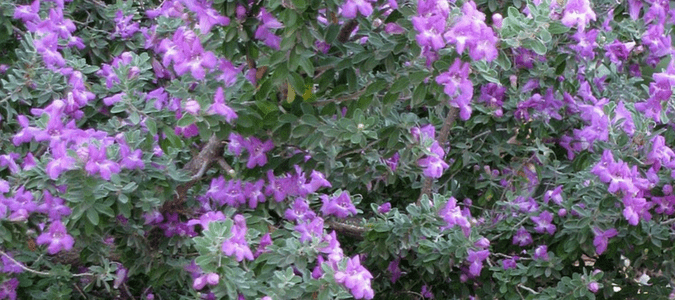
Texas Native Plants Landscaping Ideas
When designing your garden, think about the colors you want to incorporate, as well as the heights and widths of various plants. Variety is often key in garden design, but simplicity also carries weight. The following plants do well in many regions of Texas and can provide appealing accents to your garden or yard, whether planted in ceramic pots or in the ground.
Rough Agave
Capable of growing to three to five feet in height and diameter if planted in the ground, rough agave gets its name from its spiny, gray leaves, which feel slightly rough to the touch. Rough agave can also do well when planted in pots; this will also help control its size. Rough agave plants drop “pups”–offshoots that can replace the main plant once it has bloomed and died.
Red Yucca
Many gardeners may not realize that red yucca is not actually a yucca plant. This small, spiny shrub sends off tall, arching shoots decorated with coral-pink flowers from late spring through summer and into early fall. Native to central and west Texas, red yucca can tolerate very high heats and adapt to many types of soil. It can do well either planted in the ground or in a pot.
Texas Sage
Also known as Cenizo, this medium-sized shrub has small, silvery-green leaves and produces delicate violet flowers that tend to bloom just before or after a rainstorm. Once established, Texas sage is extremely heat and drought tolerant, and it does well when planted in rocky soil. Full sun and well-draining soil are best for this plant, which can also weather cold, even sub-freezing temperatures reasonably well.
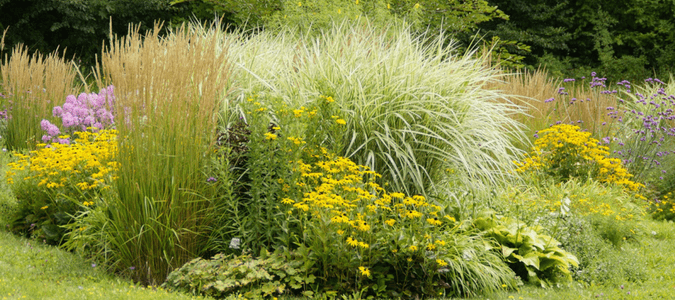
Texas Flower Bed Ideas
Planning your garden involves considering border plants, flowering bushes, ground cover and trees, along with ornamental grasses or vines that can add texture and interest to the landscape. Here are some Texas flower bed ideas you might consider for your outdoor living space:
- Mexican heather makes an attractive and hardy ground cover. This plant grows to about six inches in height with small, pointed, bright-green leaves and tiny, pretty lavender blooms.
- Ornamental grasses like big muhly or Mexican feather grass provide pops of texture. You can plant these as border plants along walkways or as a backdrop for more colorful flowering plants. Be sure to cut ornamental grasses back each winter to a small ball shape to encourage fresh growth in the spring.
ABC Can Create The Landscape Of Your Dreams
Gardening in Texas can be a fun and fulfilling pastime—as long as you don’t mind dealing with extreme heat and sun, along with mosquitoes and various other outdoor critters that might try to keep you company while you poke around in the dirt. If you’re the type of homeowner who relishes a beautiful garden but doesn’t look forward to the work that goes into creating it, ABC Home & Commercial can help you design the Texas garden of your dreams. Our landscape designers can prioritize native plants, as well as those with low water needs that are adapted to your region’s soil type, to create an eye-catching, customized and sustainable outdoor space you’ll love.